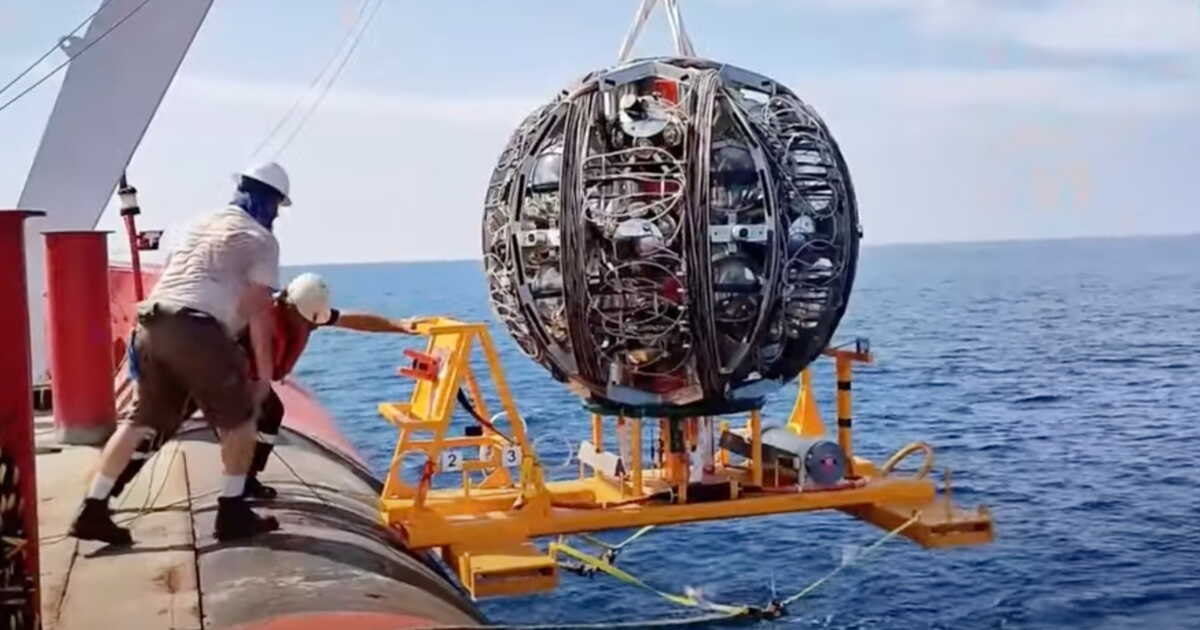In the depths of the Mediterranean Sea, at precisely 2,450 meters below surface, an extraordinary cosmic discovery has revolutionized our understanding of high-energy astrophysics. The KM3NeT telescope network detected what scientists now consider the most energetic cosmic neutrino ever recorded, carrying an unprecedented 120 petaelectronvolts of energy.
This remarkable detection occurred in February 2023, during the telescope’s construction phase when only 10% of its sensors were operational. The discovery challenges existing theories about cosmic particle acceleration and opens new avenues for understanding extreme astrophysical phenomena throughout the universe.
Revolutionary detection technology beneath Mediterranean waters
The KM3NeT observatory represents a groundbreaking approach to neutrino astronomy, utilizing the Mediterranean’s pristine depths as a natural detection medium. Located off Sicily’s coast, with a secondary installation near Toulon, this underwater telescope consists of chains anchored to the seafloor, each equipped with light-sensitive detectors.
These sophisticated sensors monitor for faint flashes produced when neutrinos interact with water molecules. Unlike conventional cosmic ray detectors, this system exploits the fact that electrically neutral neutrinos can traverse vast distances through space without interference from magnetic fields or interstellar matter.
The detection process relies on identifying muons, charged particles created when high-energy neutrinos collide with atomic nuclei. The February 2023 event stood out immediately due to its horizontal trajectory toward Greece and extraordinary energy signature, distinguishing it from typical cosmic ray interactions in Earth’s atmosphere.
| Detection Parameter | Recorded Value |
|---|---|
| Energy Level | 120 PeV |
| Trajectory Direction | Horizontal toward Greece |
| Detection Depth | 2,450 meters |
| Operational Sensors | 10% of full capacity |
Physicists had to verify extensively that this wasn’t an instrumental anomaly. Paschal Coyle from Aix-Marseille University, serving as KM3NeT spokesperson, emphasized the rigorous validation process required to confirm such an extraordinary measurement.
Unprecedented energy levels challenge cosmic understanding
This Mediterranean detection surpasses previous records by a factor of twenty, establishing new benchmarks for cosmic neutrino research. The particle’s immense energy suggests origins in the most violent processes occurring across our galaxy and beyond, possibly involving supermassive black holes or gamma-ray bursts.
Elisa Resconi, a neutrino physicist affiliated with the IceCube project at the South Pole, described this discovery as “colossal.” The IceCube observatory, which first detected cosmic neutrinos in 2012, provides valuable context for understanding the significance of this Mediterranean breakthrough.
The horizontal trajectory observed suggests the neutrino originated from a distant galactic source rather than atmospheric interactions. This geometric evidence supports theories linking high-energy neutrinos to exotic cosmic phenomena, potentially including :
- Active galactic nuclei powered by supermassive black holes
- Stellar explosions in distant galaxies
- Gamma-ray burst afterglows
- Blazar jet interactions with cosmic matter
The Mediterranean’s unique underwater environment offers advantages over ice-based detectors, providing clearer optical conditions and reduced background noise. This clarity enabled precise measurement of the neutrino’s characteristics despite the telescope’s incomplete construction status.
Future implications for cosmic exploration
The expansion of KM3NeT’s detector network promises revolutionary advances in neutrino astronomy. Since 2023, researchers have deployed twelve additional detector chains, bringing the total from 21 to 33 operational units. This growth significantly enhances detection capabilities and measurement precision.
These developments complement other cosmic research initiatives, including studies of stellar consumption events revealed by the Webb telescope, which provide insights into extreme cosmic processes that might generate high-energy neutrinos.
The Mediterranean detection network’s expansion coincides with ambitious space exploration projects, such as Japan’s lunar mission attempts with the Resilience lander, demonstrating humanity’s multi-faceted approach to understanding cosmic phenomena.
Understanding neutrino origins addresses fundamental questions about universe structure and evolution. These ghostly particles, traveling at near-light speeds, carry information about cosmic events occurring billions of light-years away, effectively serving as cosmic messengers from the universe’s most extreme environments.
The Mediterranean discovery also contributes to broader cosmological discussions, including theoretical frameworks exploring connections between Big Bang physics and fundamental principles, as neutrinos played crucial roles in early universe evolution.
Transforming astrophysics through underwater astronomy
This extraordinary detection demonstrates the potential of underwater neutrino telescopes to revolutionize cosmic research. The Mediterranean’s optical clarity and reduced atmospheric interference create ideal conditions for detecting these elusive particles, offering complementary capabilities to existing ice-based facilities.
The implications extend beyond mere detection statistics. Each high-energy neutrino provides unique information about cosmic acceleration mechanisms, potentially revealing how nature produces particles with energies exceeding those achievable in terrestrial accelerators. This knowledge could unlock secrets about cosmic ray origins and galactic magnetic field structures.
Future observations may identify specific source locations for ultra-high-energy neutrinos, enabling coordinated studies with optical telescopes, X-ray observatories, and gravitational wave detectors. Such multi-messenger astronomy approaches promise comprehensive understanding of universe’s most energetic phenomena.
The Mediterranean detection marks a pivotal moment in neutrino astronomy, establishing new energy thresholds and validating underwater detection methodologies. As KM3NeT approaches full operational capacity, scientists anticipate discovering additional record-breaking events that will further illuminate the cosmic processes responsible for accelerating particles to extraordinary energies throughout our universe.
First Appeared on
Source link












